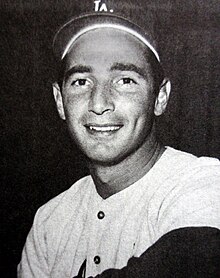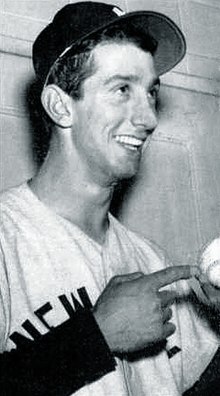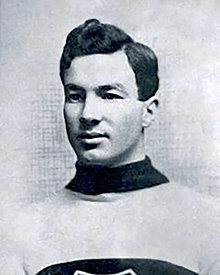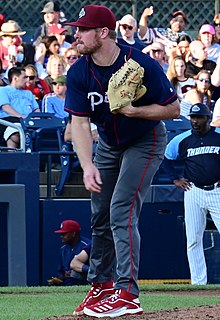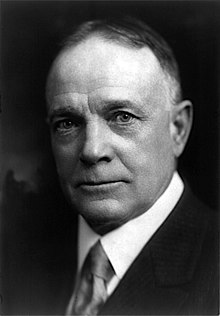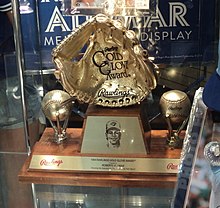Portal:Baseball
Portal maintenance status: (June 2018)
|
| Main page | Content, Categories & Topics | WikiProjects & Things you can do |
The Baseball Portal
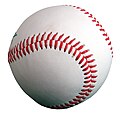
Baseball is a bat-and-ball sport played between two teams of nine players each, taking turns batting and fielding. The game occurs over the course of several plays, with each play generally beginning when a player on the fielding team, called the pitcher, throws a ball that a player on the batting team, called the batter, tries to hit with a bat. The objective of the offensive team (batting team) is to hit the ball into the field of play, away from the other team's players, allowing its players to run the bases, having them advance counter-clockwise around four bases to score what are called "runs". The objective of the defensive team (referred to as the fielding team) is to prevent batters from becoming runners, and to prevent runners' advance around the bases. A run is scored when a runner legally advances around the bases in order and touches home plate (the place where the player started as a batter).
The opposing teams switch back and forth between batting and fielding; the batting team's turn to bat is over once the fielding team records three outs. One turn batting for each team constitutes an inning. A game is usually composed of nine innings, and the team with the greater number of runs at the end of the game wins. Most games end after the ninth inning, but if scores are tied at that point, extra innings are usually played. Baseball has no game clock, though some competitions feature pace-of-play regulations such as the pitch clock to shorten game time.
Baseball evolved from older bat-and-ball games already being played in England by the mid-18th century. This game was brought by immigrants to North America, where the modern version developed. Baseball's American origins, as well as its reputation as a source of escapism during troubled points in American history such as the American Civil War and the Great Depression, have led the sport to receive the moniker of "America's Pastime"; since the late 19th century, it has been unofficially recognized as the national sport of the United States, though in modern times is considered less popular than other sports, such as American football. In addition to North America, baseball spread throughout the rest of the Americas and the Asia–Pacific in the 19th and 20th centuries, and is now considered the most popular sport in parts of Central and South America, the Caribbean, and East Asia, particularly in Japan, South Korea, and Taiwan. (Full article...)
 Featured articles - load new batch
Featured articles - load new batch
-
Image 1
Daniel Lucius "Doc" Adams (November 1, 1814 – January 3, 1899) was an American baseball player and executive who is regarded by historians as an important figure in the sport's early years. For most of his career he was a member of the New York Knickerbockers. He first played for the New York Base Ball Club in 1840 and started his Knickerbockers career five years later, continuing to play for the club into his forties and to take part in inter-squad practice games and matches against opposing teams. Researchers have called Adams the creator of the shortstop position, which he used to field short throws from outfielders. In addition to his playing career, Adams manufactured baseballs and oversaw bat production; he also occasionally acted as an umpire.
From 1847 to 1861, the Knickerbockers selected Adams as their president six times, and as a vice president, treasurer, or director in six other years. As president of the club, Adams was an advocate of rule changes in baseball that resulted in nine-man teams and nine-inning games. When the National Association of Base Ball Players (NABBP) was formed in 1858, he led the rules and regulations committee of the new organization. In his role, Adams ruled that the fields' bases should be 90 feet (27 m) apart, the modern distance, and supported the elimination of the "bound rule", which allowed for balls caught after one bounce to be recorded as outs. He resigned from his positions with the Knickerbockers and NABBP in 1862. Adams' contributions in creating baseball's rules went largely unrecognized for decades after his 1899 death, but in 1980 a letter about him appeared in The New York Times; by 1993, researcher John Thorn had written about Adams' role. Other historians have given him credit for helping to develop the sport, and Thorn has called Adams "first among the Fathers of Baseball". (Full article...) -
Image 2
Sanford Koufax (/ˈkoʊfæks/; né Braun; born December 30, 1935), nicknamed "the Left Arm of God", is an American former baseball pitcher who played 12 seasons in Major League Baseball (MLB) for the Brooklyn/Los Angeles Dodgers from 1955 to 1966. Widely regarded as one of the greatest pitchers in baseball history, Koufax was the first three-time winner of the Cy Young Award, each time winning unanimously and the only pitcher to do so when a single award was given for both the leagues; he was also named the National League Most Valuable Player in 1963. Retiring at the age of 30 due to chronic pain in his pitching elbow, Koufax was elected to the Baseball Hall of Fame in his first year of eligibility in 1972 at the age of 36, the youngest player ever elected.
Born in Brooklyn, New York, Koufax was primarily a basketball player in his youth and had pitched in only a few games before signing with the Brooklyn Dodgers at age 19. Due to the bonus rule he signed under, Koufax never pitched the minor leagues. His lack of pitching experience caused manager Walter Alston to distrust Koufax, who saw inconsistent playing time during his first six seasons. As a result, though he often showed flashes of brilliance, Koufax struggled early on. Frustrated with the way he was being managed by the Dodgers, he almost quit after the 1960 season. After making adjustments prior to the 1961 season, Koufax quickly rose to become the most dominant pitcher in the major leagues, as well as the first major sports star on the West Coast. He was an All-Star in each of his last six seasons, leading the National League (NL) in earned run average each of his last five years, in strikeouts four times, and in wins and shutouts three times each. He was the first pitcher in the live-ball era to post an earned run average below 2.00 in three different qualifying seasons, and the first ever to record a 300-strikeout season three times. (Full article...) -
Image 3
Harmon Clayton Killebrew Jr. (/ˈkɪlɪbruː/; June 29, 1936 – May 17, 2011), nicknamed "the Killer" and "Hammerin' Harmon", was an American professional baseball first baseman, third baseman, and left fielder. He spent most of his 22-year career in Major League Baseball (MLB) with the Minnesota Twins. A prolific power hitter, Killebrew had the fifth-most home runs in major league history at the time of his retirement. He was second only to Babe Ruth in American League (AL) home runs, and was the AL career leader in home runs by a right-handed batter. Killebrew was inducted into the National Baseball Hall of Fame in 1984.
Killebrew was 5-foot-11-inch (180 cm) tall and 213 pounds (97 kg). His compact swing generated tremendous power and made him one of the most feared power hitters of the 1960s, when he hit at least 40 home runs per season eight times. In total Killebrew led the league six times in home runs and three times in RBIs, and was named to 13 All-Star teams. In 1965, he played in the World Series with the Twins, who lost to the Los Angeles Dodgers. His finest season was 1969, when he hit 49 home runs, recorded 140 RBIs and won the AL Most Valuable Player Award while helping lead the Twins to the AL West pennant. (Full article...) -
Image 4
James Howard Thome (/ˈtoʊmi/; TOH-mee; born August 27, 1970) is an American former professional baseball corner infielder and designated hitter, who played in Major League Baseball (MLB) for 22 seasons (1991–2012). A prolific power hitter, Thome hit 612 home runs during his career—the eighth-most all time. He amassed a total of 2,328 hits and 1,699 runs batted in (RBIs). His career batting average was .276. He was a member of five All-Star teams and won a Silver Slugger Award in 1996.
Thome grew up in Peoria, Illinois, as part of a large blue-collar family of athletes, who predominantly played baseball and basketball. After attending Illinois Central College, he was drafted by the Indians in the 1989 draft, and made his big league debut in 1991. Early in his career, Thome played third base, before eventually becoming a first baseman. With the Indians, he was part of a core of players that led the franchise to five consecutive playoff appearances in the 1990s, including World Series appearances in 1995 and 1997. Thome spent over a decade with Cleveland, before leaving via free agency after the 2002 season, to join the Philadelphia Phillies, with whom he spent the following three seasons. Traded to the Chicago White Sox before the 2006 season, he won the American League (AL) Comeback Player of the Year Award that year and joined the 500 home run club during his three-season tenure with the White Sox. By this point in his career, back pain limited Thome to being a designated hitter. After stints with the Los Angeles Dodgers and Minnesota Twins, he made brief returns to Cleveland and Philadelphia, before ending his career with the Baltimore Orioles. Upon retiring, Thome accepted an executive position with the White Sox. (Full article...) -
Image 5The 2004 World Series was the championship series of Major League Baseball's (MLB) 2004 season. The 100th edition of the World Series, it was a best-of-seven playoff between the American League (AL) champion Boston Red Sox and the National League (NL) champion St. Louis Cardinals; the Red Sox swept the Cardinals in four games. The series was played from October 23 to 27, 2004, at Fenway Park and Busch Memorial Stadium, broadcast on Fox, and watched by an average of just under 25.5 million viewers. The Red Sox's World Series championship was their first since 1918, ending the Curse of the Bambino.
The Cardinals earned their berth into the playoffs by winning the NL Central division title, and had the best win–loss record in the NL. The Red Sox won the AL wild card to earn theirs. The Cardinals reached the World Series by defeating the Los Angeles Dodgers in the best-of-five NL Division Series and the Houston Astros in the best-of-seven NL Championship Series. The Red Sox defeated the Anaheim Angels in the AL Division Series. After trailing three games to none to the New York Yankees in the AL Championship Series, the Red Sox came back to win the series, advancing to their first World Series since 1986. The Cardinals made their first appearance in the World Series since 1987. With the New England Patriots winning Super Bowl XXXVIII, the World Series victory made Boston the first city to have Super Bowl and World Series championship teams in the same year (2004) since Pittsburgh in 1979. The Red Sox became the third straight wild card team to win the World Series; the Anaheim Angels won in 2002 and the Florida Marlins won in 2003. (Full article...) -
Image 6
Alfred Manuel "Billy" Martin Jr. (May 16, 1928 – December 25, 1989) was an American Major League Baseball second baseman and manager who, in addition to leading other teams, was five times the manager of the New York Yankees. First known as a scrappy infielder who made considerable contributions to the championship Yankee teams of the 1950s, he then built a reputation as a manager who would initially make bad teams good, before ultimately being fired amid dysfunction. In each of his stints with the Yankees he managed them to winning records before being fired by team owner George Steinbrenner or resigning under fire, usually amid a well-publicized scandal such as Martin's involvement in an alcohol-fueled fight.
Martin was born in a working-class section of Berkeley, California. His skill as a baseball player gave him a route out of his home town. Signed by the Pacific Coast League Oakland Oaks, Martin learned much from Casey Stengel, the man who would manage him both in Oakland and in New York, and enjoyed a close relationship with Stengel. Martin's spectacular catch of a wind-blown Jackie Robinson popup late in Game Seven of the 1952 World Series saved that series for the Yankees, and he was the hitting star of the 1953 World Series, earning the Most Valuable Player award in the Yankee victory. He missed most of two seasons, 1954 and 1955, after being drafted into the Army, and his abilities never fully returned; the Yankees traded him after a brawl at the Copacabana club in New York during the 1957 season. Martin bitterly resented being traded, and did not speak to Stengel for years, a time during which Martin completed his playing career with various teams. (Full article...) -
Image 7Ross with the Montreal Wanderers, circa 1907–18
Arthur Howey Ross (January 13, 1885 – August 5, 1964) was a Canadian professional ice hockey player and executive from 1905 until 1954. Regarded as one of the best defenders of his era by his peers, he was one of the first to skate with the puck up the ice rather than pass it to a forward. He was on Stanley Cup championship teams twice in a playing career that lasted thirteen seasons; in January 1907 with the Kenora Thistles and 1908 with the Montreal Wanderers. Like other players of the time, Ross played for several different teams and leagues, and is noted for his time with the Wanderers while they were members of the National Hockey Association (NHA) and its successor, the National Hockey League (NHL). In 1911, he led one of the first organized player strikes over increased pay. When the Wanderers' home arena burned down in January 1918, the team ceased operations and Ross retired as a player.
After several years as an on-ice official, he was named head coach of the Hamilton Tigers for one season. When the Boston Bruins were formed in 1924, Ross was hired as the first coach and general manager of the team. He later coached the team on three separate occasions until 1945, and stayed as general manager until his retirement in 1954. Ross helped the Bruins finish first place in the league ten times and win the Stanley Cup three times; Ross personally coached the team to two of those victories. After being hired by the Bruins, Ross, along with his wife and two sons, moved to a suburb of Boston, and he became an American citizen in 1938. He died near Boston in 1964. (Full article...) -
Image 8Adenhart pitching for the Salt Lake Bees in 2008
Nicholas James Adenhart (August 24, 1986 – April 9, 2009) was an American right-handed baseball starting pitcher who played parts of two seasons in Major League Baseball (MLB) for the Los Angeles Angels of Anaheim. In just four career games, Adenhart pitched 18 innings and posted a win-loss record of 1–0.
A graduate of Williamsport High School, Adenhart was highly touted as a high school prospect until an injury in his final game required Tommy John surgery. The Angels drafted him in the 14th round of the 2004 Major League Baseball draft, and began playing in their minor league system after the surgery was a success. He spent three full seasons in the minor leagues before making his major league debut on May 1, 2008. After appearing in three games, Adenhart spent the rest of 2008 in the minor leagues developing his skills, and in 2009 he earned a spot in the Angels' starting rotation. (Full article...) -
Image 9

KARE (channel 11) is a television station licensed to Minneapolis, Minnesota, United States, serving as the Twin Cities area's NBC affiliate. Owned by Tegna Inc., the station maintains studios on Olson Memorial Highway (MN 55) in Golden Valley and a transmitter at the Telefarm site in Shoreview, Minnesota.
Channel 11 began broadcasting on September 1, 1953. It was originally shared by WMIN-TV in St. Paul and WTCN-TV in Minneapolis; the two stations shared an affiliation with ABC and alternated presenting local programs. In 1955, Consolidated Television and Radio bought both stations and merged them as WTCN-TV from the Minneapolis studios in the Calhoun Beach Hotel. The station presented several regionally and nationally notable children's shows in its early years as well as local cooking, news, and sports programs. Time Inc. purchased the station in 1957. Under its ownership, ABC switched its affiliation to KMSP-TV (channel 9), leaving channel 11 to become an independent station that broadcast games of the Minnesota Twins baseball team, movies, and syndicated programs. This continued under two successive owners: Chris-Craft Industries and Metromedia. By the late 1970s, WTCN was one of the nation's most financially successful independent stations. (Full article...) -
Image 10

WSNS-TV (channel 44) is a television station in Chicago, Illinois, United States, serving as the local outlet for the Spanish-language network Telemundo. It is owned and operated by NBCUniversal's Telemundo Station Group alongside NBC outlet WMAQ-TV (channel 5). The two stations share studios at the NBC Tower on North Columbus Drive in the city's Streeterville neighborhood and broadcast from the same transmitter atop the Willis Tower in the Chicago Loop.
WSNS-TV began broadcasting in 1970. Originally specializing in the automated display of news headlines, it evolved into Chicago's third full-fledged independent station, carrying movies, local sports, and other specialty programming. This continued until 1980, when WSNS became the Chicago-area station for ON TV, an over-the-air subscription television (STV) service owned by Oak Industries, which took a minority ownership stake in the station. While ON TV was successful in Chicago and the subscription system became the second-largest in the country by total subscribers, the rise of cable television precipitated the end of the business in 1985, with WSNS-TV as the last ON TV station standing. (Full article...) -
Image 11Paschal before a game during the 1925 New York Yankees season
Benjamin Edwin Paschal (October 13, 1895 – November 10, 1974) was an American baseball outfielder who played eight seasons in Major League Baseball from 1915 to 1929, mostly for the New York Yankees. After two "cup of coffee" stints with the Cleveland Indians in 1915 and the Boston Red Sox in 1920, Paschal spent most of his career as the fourth outfielder and right-handed pinch hitter of the Yankees' Murderers' Row championship teams of the late 1920s. Paschal is best known for hitting .360 in the 1925 season while standing in for Babe Ruth, who missed the first 40 games with a stomach ailment.
During his time in baseball, Paschal was described as a five-tool player who excelled at running, throwing, fielding, hitting for average, and power. However, his playing time with the Yankees was limited because they already had future Baseball Hall of Famers Ruth and Earle Combs, and star Bob Meusel, in the outfield. Paschal was considered one of the best bench players in baseball during his time with the Yankees, and sportswriters wrote how he would have started for most other teams in the American League. He was one of the best pinch hitters in the game during the period, at a time when the term was still relatively new to baseball. (Full article...) -
Image 12
Mariano Rivera (born November 29, 1969) is a Panamanian-American former professional baseball pitcher who played 19 seasons in Major League Baseball (MLB) for the New York Yankees, from 1995 to 2013. Nicknamed "Mo" and "Sandman", he spent most of his career as a relief pitcher and served as the Yankees' closer for 17 seasons. A thirteen-time All-Star and five-time World Series champion, he is MLB's career leader in saves (652) and games finished (952). Rivera won five American League (AL) Rolaids Relief Man Awards and three Delivery Man of the Year Awards, and he finished in the top three in voting for the AL Cy Young Award four times. He was inducted into the Baseball Hall of Fame as part of its class of 2019 in his first year of eligibility, and is to date the only player ever to be elected unanimously by the Baseball Writers' Association of America (BBWAA).
Raised in the modest Panamanian fishing village of Puerto Caimito, Rivera was an amateur player until he was signed by the Yankees organization in 1990. He debuted in the major leagues in 1995 as a starting pitcher, before permanently converting to a relief pitcher late that year. After a breakthrough season in 1996 as a setup man, he became the Yankees' closer in 1997. In the following seasons, he established himself as one of baseball's top relievers, leading the major leagues in saves in 1999, 2001, and 2004. Rivera primarily threw a sharp-moving, mid-90s mile-per-hour cut fastball that frequently broke hitters' bats and earned a reputation as one of the league's toughest pitches to hit. With his presence at the end of games, signaled by his foreboding entrance song "Enter Sandman", Rivera was a key contributor to the Yankees' dynasty in the late 1990s and early 2000s that won four championships in five years. He was an accomplished postseason performer, winning the 1999 World Series Most Valuable Player (MVP) Award and the 2003 AL Championship Series MVP Award, while setting postseason records that included lowest earned run average (ERA) (0.70) and most saves (42). (Full article...) -
Image 13Los Angeles Angels center fielder Mike Trout hits a home run on a pitch from New York Mets pitcher Tommy Milone on May 21, 2017.
Baseball is a bat-and-ball sport played between two teams of nine players each, taking turns batting and fielding. The game occurs over the course of several plays, with each play generally beginning when a player on the fielding team, called the pitcher, throws a ball that a player on the batting team, called the batter, tries to hit with a bat. The objective of the offensive team (batting team) is to hit the ball into the field of play, away from the other team's players, allowing its players to run the bases, having them advance counter-clockwise around four bases to score what are called "runs". The objective of the defensive team (referred to as the fielding team) is to prevent batters from becoming runners, and to prevent runners' advance around the bases. A run is scored when a runner legally advances around the bases in order and touches home plate (the place where the player started as a batter).
The initial objective of the batting team is to have a player reach first base safely; this generally occurs either when the batter hits the ball and reaches first base before an opponent retrieves the ball and touches the base, or when the pitcher persists in throwing the ball out of the batter's reach. Players on the batting team who reach first base without being called "out" can attempt to advance to subsequent bases as a runner, either immediately or during teammates' turns batting. The fielding team tries to prevent runs by using the ball to get batters or runners "out", which forces them out of the field of play. The pitcher can get the batter out by throwing three pitches which result in strikes, while fielders can get the batter out by catching a batted ball before it touches the ground, and can get a runner out by tagging them with the ball while the runner is not touching a base. (Full article...) -
Image 14
Tyler Wayne Skaggs (July 13, 1991 – July 1, 2019) was an American left-handed professional baseball starting pitcher who played in Major League Baseball (MLB) for the Arizona Diamondbacks and Los Angeles Angels from 2012 until his death in 2019.
A native of Woodland Hills, California, and a graduate of Santa Monica High School, Skaggs was a supplemental first-round selection for the Angels in the 2009 Major League Baseball draft. He was traded to the Diamondbacks the following year as part of an exchange for pitcher Dan Haren and rose through Arizona's farm system. After two consecutive appearances at the All-Star Futures Game in 2011 and 2012, Skaggs made his major league debut on August 22, 2012, against the Miami Marlins. He remained with the Diamondbacks through the end of the season, but was optioned to the minor leagues in 2013. (Full article...) -
Image 15
Thurman Lowell Tucker (September 26, 1917 – May 7, 1993) was an American professional baseball player. A center fielder, Tucker played in Major League Baseball for nine seasons in the American League with the Chicago White Sox and Cleveland Indians. In 701 career games, Tucker recorded a batting average of .255 and accumulated 24 triples, nine home runs, and 179 runs batted in (RBI). Due to his resemblance of the film comedian Joe E. Brown, Tucker was nicknamed "Joe E.".
Born and raised in Texas, Tucker first played professionally with the Siloam Springs Travelers. After gradually progressing through minor league baseball, he signed with the Chicago White Sox before the 1941 season. His major league debut came the following year and he spent two years as the White Sox's starting center fielder until he enlisted in the armed forces during World War II. Upon his return, Tucker played two more seasons for the White Sox. Subsequently, he was traded to the Cleveland Indians, for whom he played four years, and continued to play minor league baseball throughout the 1950s. After his retirement, he became a major league scout and insurance agent. (Full article...)
General images - load new batch
-
Image 1Jackie Robinson in 1945, with the era's Kansas City Royals, a barnstorming squad associated with the Negro American League's Kansas City Monarchs (from Baseball)
-
Image 3By the 1860s Civil War, baseball (bottom) had overtaken its fellow bat-and-ball sport cricket (top) in popularity within the United States. (from History of baseball)
-
Image 4Defensive positions on a baseball field, with abbreviations and scorekeeper's position numbers (not uniform numbers) (from Baseball)
-
Image 5The American Tobacco Company's line of baseball cards featured shortstop Honus Wagner of the Pittsburgh Pirates from 1909 to 1911. In 2007, the card shown here sold for $2.8 million. (from Baseball)
-
Image 6A well-worn baseball (from Baseball)
-
Image 7A New York Yankees batter (Andruw Jones) and a Boston Red Sox catcher at Fenway Park (from Baseball)
-
Image 8Cover of Official Base Ball Rules, 1921 edition, used by the American League and National League (from Baseball rules)
-
Image 9The strike zone, which determines the outcome of most pitches, varies in vertical length depending on the batter's typical height while swinging. (from Baseball rules)
-
Image 10Rickey Henderson—the major leagues' all-time leader in runs and stolen bases—stealing third base in a 1988 game (from Baseball)
-
Image 11A first baseman receives a pickoff throw, as the runner dives back to first base. (from Baseball)
-
Image 13Pick-off attempt on runner (in red) at first base (from Baseball rules)
-
Image 15Sadaharu Oh managing the Japan national team in the 2006 World Baseball Classic. Playing for the Central League's Yomiuri Giants (1959–80), Oh set the professional world record for home runs with 868. (from History of baseball)
-
Image 17Japanese-Americans spectating a World War II-era game while in an internment camp. America's ties to immigrants and to Japan have been deeply shaped by a shared baseball heritage. (from History of baseball)
-
Image 18In May 2010, the Philadelphia Phillies' Roy Halladay pitched the 20th major league perfect game. That October, he pitched only the second no-hitter in MLB postseason history. (from History of baseball)
-
Image 19Pesäpallo, a Finnish variation of baseball, was invented by Lauri "Tahko" Pihkala in the 1920s, and after that, it has changed with the times and grown in popularity. Picture of Pesäpallo match in 1958 in Jyväskylä, Finland. (from Baseball)
-
Image 202013 World Baseball Classic championship match between the Dominican Republic and Puerto Rico, March 20, 2013 (from Baseball)
-
Image 21The standard fielding positions (from Baseball rules)
-
Image 22Baserunners generally stand a short distance away from their base between pitches, preparing themselves to either go back or steal the next base. (from Baseball rules)
-
Image 23A game from the Cantigas de Santa Maria, c. 1280, involving tossing a ball, hitting it with a stick and competing with others to catch it (from History of baseball)
-
Image 26The strike zone determines the result of most pitches, and varies in vertical length for each batter. (from Baseball)
-
Image 27Fenway Park, home of the Boston Red Sox. The Green Monster is visible beyond the playing field on the left. (from Baseball)
-
Image 29Alexander Cartwright, father of modern baseball (from History of baseball)
-
Image 30A pitcher handing off the ball after being taken out of the game during a mound meeting. (from Baseball)
-
Image 31A batter follows through after swinging at a pitched ball. (from Baseball rules)
-
Image 32Two players on the baseball team of Tokyo, Japan's Waseda University in 1921 (from Baseball)
-
Image 33Baseball games sometimes end in a walk-off home run, with the batting team usually gathering at home plate to celebrate the scoring of the winning run(s). (from Baseball rules)
-
Image 34The typical motion of a right-handed pitcher (from Baseball rules)
-
Image 35Pitchers are generally substituted during mound visits (team gatherings at the pitcher's mound). (from Baseball rules)
-
Image 37Jackie Robinson in 1945, with the era's Kansas City Royals, a barnstorming squad associated with the Negro American League's Kansas City Monarchs (from History of baseball)
-
Image 38Cy Young—the holder of many major league career marks, including wins and innings pitched, as well as losses—in 1908. MLB's annual awards for the best pitcher in each league are named for Young. (from Baseball)
-
Image 39Diagram of a baseball field Diamond may refer to the square area defined by the four bases or to the entire playing field. The dimensions given are for professional and professional-style games. Children often play on smaller fields. (from Baseball)
-
Image 40Sadaharu Oh managing the Japan national team in the 2006 World Baseball Classic. Playing for the Central League's Yomiuri Giants (1959–80), Oh set the professional world record for home runs. (from Baseball)
-
Image 411906 World Series, infielders playing "in" for the expected bunt and the possible play at the plate with the bases loaded (from Baseball rules)
-
Image 42An Afghan girl playing baseball in August 2002 (from Baseball)
-
Image 43A runner sliding into home plate and scoring. (from Baseball)
-
Image 45The NL champion New York Giants baseball team, 1913. Fred Merkle, sixth in line, had committed a baserunning gaffe in a crucial 1908 game that became famous as Merkle's Boner. (from History of baseball)
 Good articles - load new batch
Good articles - load new batch
-
Image 1
Shelby Charles Miller (born October 10, 1990) is an American professional baseball pitcher who is currently a free agent. He has previously played in Major League Baseball (MLB) for the St. Louis Cardinals, Atlanta Braves, Arizona Diamondbacks, Texas Rangers, Chicago Cubs, Pittsburgh Pirates, San Francisco Giants, Los Angeles Dodgers and Detroit Tigers.
Drafted by the Cardinals out of Brownwood High School in the first round of the 2009 MLB draft, Miller was one of the sport's highest-rated prospects. He is a recipient of numerous awards, including the Cardinals' minor league pitcher of the year in 2010, Baseball Americas number one Cardinals prospect from 2009 to 2011, and selection to the All-Star Futures Game in 2010 and 2011. A fourth award, MLB.com's Pitching Performance of the Month, was the result of his first MLB complete game shutout in May 2013, a one-hitter against the Colorado Rockies. ('Full article...) -
Image 2The 2019 World Series was the championship series of Major League Baseball's (MLB) 2019 season. The 115th edition of the World Series, it was a best-of-seven playoff between the American League champion Houston Astros and the National League champion Washington Nationals. The series was played from October 22 to October 30. Washington upset the favored Astros, four games to three, to secure its first title in franchise history and first in the capital city since the 1924 series. Washington pitcher Stephen Strasburg was named the World Series Most Valuable Player (MVP) after earning two wins in the series.
The Astros had home-field advantage because they had the better regular-season record. It was the third World Series in which home-field advantage was decided by the regular-season records of the American and National league champions, a practice that started in the 2017 season. It was the first World Series in which the Houston Astros had home-field advantage. The series was played in a 2–3–2 format, with the Astros hosting Games 1, 2, 6, and 7; and the Nationals hosting Games 3, 4, and 5. (Full article...) -
Image 3The 1999 National League Wild Card tie-breaker game was a one-game extension to Major League Baseball's (MLB) 1999 regular season, played between the New York Mets and Cincinnati Reds to determine the winner of the National League (NL) wild card. It was played at Cinergy Field in Cincinnati, on October 4, 1999. The Mets won the game, 5–0, with starting pitcher Al Leiter pitching a two-hit shutout. As a result, the Mets qualified for the postseason and the Reds did not.
The game was necessary after both teams finished the season with identical win–loss records of 96–66. Some described the Mets as collapsing late in the season while the race between the Reds and their division rival Houston Astros was close enough to create the possibility of a three-way tie. The Reds won a coin flip late in the season which, by rule at the time, awarded them home field for the game. Upon winning, the Mets advanced to National League Division Series (NLDS) where they defeated the Arizona Diamondbacks, 3 games to 1. They then advanced to the National League Championship Series (NLCS) but were defeated by the Atlanta Braves, 4 games to 2. This game counted as the 163rd regular-season game by both teams, with all events in the game added to regular-season statistics. (Full article...) -
Image 4Anderson with the Lehigh Valley IronPigs in 2021
Robert Chase Anderson (born November 30, 1987) is an American professional baseball pitcher who is a free agent. He has previously played in Major League Baseball (MLB) for the Arizona Diamondbacks, Milwaukee Brewers, Toronto Blue Jays, Philadelphia Phillies, Cincinnati Reds, Tampa Bay Rays, Colorado Rockies, Boston Red Sox, and Texas Rangers.
Anderson was born in Wichita Falls, Texas, and helped his father with the family business following his parents' divorce. He was a standout pitcher at S. H. Rider High School, pitching three no-hitters as a senior in 2006 and setting a school record for career strikeouts, but his slender build limited attention from college baseball recruiters. He spent two seasons with North Central Texas College before transferring to the University of Oklahoma for the 2009 season. The Diamondbacks selected Anderson in the ninth round of the 2009 MLB Draft. He spent the next several years rising through the team's farm system, suffering a setback in 2011 when an elbow injury caused him to miss nearly the entire season. Anderson made his major league debut for the Diamondbacks in 2014. (Full article...) -
Image 5
Harry Clifton "Curley" Byrd (February 12, 1889 – October 2, 1970) was an American university administrator, educator, athlete, coach, and politician. Byrd began a long association with the University of Maryland as an undergraduate in 1905, and eventually rose to the position of university president from 1936 to 1954.
In the interim, he had also served as the university's athletic director and head coach for the football and baseball teams. Byrd amassed a 119–82–15 record in football from 1911 to 1934 and 88–73–4 record in baseball from 1913 to 1923. In graduate school at Georgetown University, he became one of football's early users of the newly legalized forward pass, and he had a brief baseball career including one season as pitcher for the San Francisco Seals. (Full article...) -
Image 6
Jarrod Scott Saltalamacchia (/ˌsɒltələˈmɑːkiə/; born May 2, 1985) is an American former professional baseball catcher. Between 2007 and 2018, he played in Major League Baseball (MLB) for the Atlanta Braves, Texas Rangers, Boston Red Sox, Miami Marlins, Arizona Diamondbacks, Detroit Tigers, and Toronto Blue Jays.
Raised in West Palm Beach, Florida, Saltalamacchia attended Royal Palm Beach High School. His performance on the institution's baseball team drew the attention of scouts, and the Braves selected him in the first round of the 2003 MLB Draft. He spent four years in the Braves' farm system, but in 2007, injuries to both of Atlanta's regular catchers forced them to call him up to the major leagues. Saltalamacchia was prevented from becoming a regular catcher for the Braves by the presence of Brian McCann, and so he became the centerpiece of a trading deadline deal with the Rangers in 2007. Shortly after becoming the team's starting catcher in 2009, a bout of thoracic outlet syndrome forced Saltalamacchia to undergo season-ending rib removal surgery, and lingering issues from the surgery caused him to suffer from the "yips" in 2010. (Full article...) -
Image 7
James Evan Gattis (born August 18, 1986) is an American former professional baseball designated hitter and catcher. He played in Major League Baseball (MLB) for the Atlanta Braves and Houston Astros. Gattis has also earned the nickname of El Oso Blanco or The White Bear, due to his raw power capabilities when playing for the Venezuelan Professional Baseball League. While with Atlanta, he played catcher and occasionally left field.
Gattis was a premier amateur baseball player in the Dallas–Fort Worth area through high school. However, anxiety and substance abuse led him to abandon his scholarship to Texas A&M University. After wandering around the Western United States for four years, he returned to baseball, and was drafted by the Braves in 2010. (Full article...) -
Image 8Leon Day (October 30, 1916 – March 13, 1995) was an American professional baseball pitcher who spent the majority of his career in the Negro leagues. Recognized as one of the most versatile athletes in the league during his prime, Day could play every position, with the exception of catcher, and often was the starting second baseman or center fielder when he was not on the mound. A right-handed pitcher with a trademark no wind-up delivery, Day excelled at striking batters out, especially with his high-speed fastball. At the same time, he was an above-average contact hitter, which, combined with his effectiveness as a baserunner and his tenacious fielding, helped cement Day as one of the most dynamic players of the era.
Debuting in the Negro leagues in 1934, Day played with the Baltimore Black Sox, Newark Eagles, and Baltimore Elite Giants during his career. In 1937, Day had the best season of his career as a member of the Eagles, finishing with a perfect record of 13–0 and a batting average over .300. Day also played Puerto Rican winter ball in the offseasons. He holds both the Negro and Puerto Rican league records for strikeouts in a game, and appeared in the most East–West All-Star Games. (Full article...) -
Image 9
Ryan Joseph Braun (born November 17, 1983) is an American former professional baseball left fielder who played his entire career for the Milwaukee Brewers of Major League Baseball (MLB) from 2007 to 2020. Braun played right field and first base during his career, and was a third baseman during his rookie season.
Braun was a two-time All-American at the University of Miami, where he was named National Freshman of the Year by Baseball America in 2003. The Brewers drafted him in the first round (fifth overall) in the 2005 MLB draft. He was the team's Minor League Player of the Year in 2006. (Full article...) -
Image 10
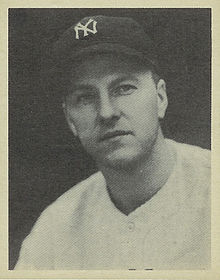
Montgomery Marcellus Pearson (September 2, 1908 – January 27, 1978) was an American baseball pitcher who played ten seasons in Major League Baseball (MLB). Nicknamed "Hoot", he played for the Cleveland Indians, New York Yankees and Cincinnati Reds from 1932 to 1941. He batted and threw right-handed and served primarily as a starting pitcher.
Pearson played minor league baseball for three different teams until 1932, when he signed with the Cleveland Indians. After spending four seasons with the organization, Pearson was traded to the New York Yankees, where he spent the next five years. At the conclusion of the 1940 season, he was traded to the Cincinnati Reds, with whom he played his last game on August 5, 1941. A four-time World Series champion, Pearson holds the MLB record for lowest walks plus hits per inning pitched (WHIP) in the postseason. He is noted for pitching the first no-hitter at the original Yankee Stadium. (Full article...) -
Image 11
William (Billy) Ashley Sunday (November 19, 1862 – November 6, 1935) was an American evangelist and professional baseball outfielder. He played for eight seasons in the National League before becoming the most influential American preacher during the first two decades of the 20th century.
Born into poverty near Ames, Iowa, Sunday spent some years at the Iowa Soldiers' Orphans' Home before working at odd jobs and playing for local running and baseball teams. His speed and agility provided him the opportunity to play baseball in the major leagues for eight years. (Full article...) -
Image 12
John Samuel "Jocko" Thompson (January 17, 1917 – February 3, 1988) was a professional baseball pitcher. He played all or part of four seasons for the Philadelphia Phillies of Major League Baseball from 1948 to 1951. He also served in the Army of the United States as a first lieutenant in the European theater during World War II. Thompson played in Major League Baseball during the Whiz Kids era during a career which spanned 12 seasons (1940–1941, 1946–1955). After attending Northeastern University, Thompson appeared as a situational pitcher and spot starter during the 1948, 1949, and 1950 seasons with the Phillies, and went 4–8 in his only season as a regular member of the team's starting rotation. After demotion to the minors in 1952, Thompson retired from baseball after the 1955 season.
Before his major league career, Thompson entered the military and participated in Operation Market Garden, where he led a platoon to secure a bridge over the Maas River. He served in the Army from 1941 to 1945. In 2004, the bridge that his platoon captured was renamed in his honor. (Full article...) -
Image 13
Brandon Chase Marsh (born December 18, 1997) is an American professional baseball outfielder for the Philadelphia Phillies of Major League Baseball (MLB). He previously played in MLB for the Los Angeles Angels.
Born in Buford, Georgia, Marsh was a multi-sport athlete at Buford High School, where he won a state championship title as a junior. The Angels selected him in the second round of the 2016 MLB Draft, but he missed the 2016 season with a back injury. After debuting with the Orem Owlz in 2017, Marsh progressed through the Angels' farm system, including a breakout turn with the Southern League in 2019. When the 2020 Minor League Baseball season was canceled due to the COVID-19 pandemic, Marsh was invited to continue his development at an alternate training site. (Full article...) -
Image 14
Kyle Rodney Kendrick (born August 26, 1984) is an American former professional baseball pitcher, who played for the Philadelphia Phillies, Colorado Rockies, and Boston Red Sox of Major League Baseball (MLB).
Kendrick was born in Houston, Texas but attended high school in Mount Vernon, Washington. While growing up, he was greatly influenced by his father, from whom he developed his composure when pitching. Upon graduation, Kendrick turned down a scholarship to play college football, instead signing a contract to begin his pro baseball career with the Phillies. After a slow ascent through Minor League Baseball (MiLB), he made his MLB debut in 2007, and was a member of the starting rotation of the 2008 World Series Championship team. (Full article...) -
Image 15

WNUV (channel 54) is a television station in Baltimore, Maryland, United States, affiliated with The CW. It is owned by Cunningham Broadcasting, which maintains a local marketing agreement (LMA) with Sinclair Broadcast Group, owner of Fox/MyNetworkTV affiliate WBFF (channel 45), for the provision of programming and certain services. However, Sinclair effectively owns WNUV, as the majority of Cunningham's stock is owned by the family of deceased group founder Julian Smith. Sinclair also operates TBD affiliate WUTB (channel 24) under a separate shared services agreement with Deerfield Media. The stations share studios on 41st Street off the Jones Falls Expressway on Television Hill in the Woodberry neighborhood of north Baltimore; WBFF and WNUV are also broadcast from the same tower on the hill.
WNUV began broadcasting on July 1, 1982. During the day, it ran specialty programming from the Financial News Network, which was subsidized by its nighttime broadcast of Super TV, a subscription television service that operated in the Washington and Baltimore areas. Super TV peaked at 30,000 Baltimore subscribers in August 1983, but even though the city of Baltimore was late to be wired for cable, the industry suffered a national decline in the mid-1980s, and WNUV ceased airing Super TV on March 31, 1986. In preparation for its closure, the station had begun to recast itself as a general-entertainment independent station as early as 1984. The founding owner and namesake, New-Vision, Inc., sold the station to ABRY Communications in 1989; ABRY upgraded the transmitter and increased the station's visibility with a campaign allowing residents to vote on programming choices. (Full article...)
Did you know (auto-generated) - load new batch

- ... that when baseball outfielder Brick Eldred was suspended by his team for refusing to pay a fine, another team acquired him, paid the fine, and gave him a raise?
- ... that while waiting for an interview, journalist Rod Beaton was involved in a shoving incident with baseball player Barry Bonds?
- ... that Cy Block and Ross Horning testified before the United States Congress about how the reserve clause limited their careers in professional baseball?
- ... that the 2024 inductees to the Delaware Sports Museum and Hall of Fame include a man with Down syndrome who has lifted 425 pounds (193 kg), an "average gymnast" turned Olympics judge, a "preeminent sportswriter", the state's "greatest high hurdler", the "inventor" of the modern sports mascot, a record-setting 10-year-old, a champion gymnast, an Olympic field hockey player, and a pro baseball player in five countries?
- ... that the six highest Minor League Baseball season attendance counts were all at Sahlen Field?
- ... that under a rules draft presented at the 1857 baseball convention, baseball bats would have been allowed to be shaved flat on one side?
- ... that the ownership group of San Diego's MLS team includes a Native American tribe and baseball player Manny Machado?
- ... that Mark Hutton was the first Australian to be a starting pitcher in a Major League Baseball game?
Quotes
| I believe in the Rip Van Winkle Theory: that a man from 1910 must be able to wake up after being asleep for 70 years, walk into a ballpark, and understand baseball perfectly.
— Bowie Kuhn, Former Major League Commissioner
|
 Featured lists - load new batch
Featured lists - load new batch
-
Image 1

1998 Rookie of the Year Award winner Kerry Wood is one of two Cubs first-round draft picks so honored.
The Chicago Cubs are a Major League Baseball (MLB) franchise based in Chicago, Illinois. They play in the National League Central division. Since the institution of MLB's Rule 4 Draft, the Cubs have selected 68 players in the first round. Officially known as the "First-Year Player Draft", the Rule 4 Draft is MLB's primary mechanism for assigning amateur baseball players from high schools, colleges, and other amateur baseball clubs to its teams. The draft order is determined based on the previous season's standings, with the team possessing the worst record receiving the first pick. In addition, teams which lost free agents in the previous off-season may be awarded compensatory or supplementary picks.
Of the 68 players picked in the first round by the Cubs, 32 have been pitchers, the most of any position; 24 of these were right-handed, while 6 were left-handed. Sixteen players picked in the initial round were outfielders, while ten shortstops, two catchers, and one player each at first base, second base, and third base were also taken. The Cubs drafted 26 players out of high school, and 32 out of college. Chicago has drafted eleven players from high schools or colleges in the state of California, with six more coming from Texas and five from Indiana. The Cubs have also taken four players from their home state of Illinois. (Full article...) -
Image 2
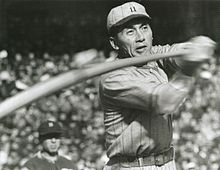
Fumio Fujimura was the first player in Nippon Professional Baseball history to hit for the cycle and also the first to hit multiple cycles.
In baseball, completing the cycle is the accomplishment of hitting a single, a double, a triple, and a home run in the same game. Collecting the hits in that order is known as a "natural cycle", which has occurred five times in Nippon Professional Baseball (NPB). The cycle itself is rare in NPB, occurring 76 times since Fumio Fujimura's first cycle during the single league era in 1948. In terms of frequency, the cycle is roughly as common as a no-hitter (90 occurrences in NPB history); Baseball Digest calls it "one of the rarest feats in baseball". Hitting for the cycle was not recognized in Japanese professional baseball until former Major League Baseball (MLB) player Daryl Spencer made a remark about it after hitting for the cycle with the Hankyu Braves in 1965. Of the 12 current NPB teams, only the Tohoku Rakuten Golden Eagles have never had at least one player hit for the cycle.
The most cycles hit by a player in Nippon Professional Baseball is three, accomplished by Bobby Rose. Playing for the Yokohama BayStars, Rose hit his first cycle on May 2, 1995, the next on April 29, 1997, and his final cycle on June 30, 1999. Other than Rose, only three other NPB players have hit multiple cycles: Fumio Fujimura with the Osaka Tigers and Hiromi Matsunaga with the Hankyu/Orix Braves and Kosuke Fukudome with the Chunichi Dragons and the Hanshin Tigers, all with two. Fujimura is also the only player to have hit a cycle during both the single league era and the current dual league era. The 2003 NPB season saw the most cycles hit in a single season—five. That season also saw the only instance of cycles occurring in two different games on the same day: on July 1, hit by Atsunori Inaba of the Yakult Swallows and Arihito Muramatsu of the Fukuoka Daiei Hawks. The next day, Shinjiro Hiyama became the third player to hit for the cycle in two days. Conversely, the longest period of time between two players hitting for the cycle is one day shy of 6 years. The drought has lasted from Michihiro Ogasawara's cycle in 2008 until Rainel Rosario's in 2014. (Full article...) -
Image 3

Greg Maddux has won 18 Gold Gloves, the most in Major League Baseball history.
The Gold Glove Award is the award given annually to the Major League Baseball players judged to have exhibited superior individual fielding performances at each fielding position in both the National League (NL) and the American League (AL), as voted by the managers and coaches in each league. Managers are not permitted to vote for their own players. Eighteen Gold Gloves are awarded each year (with the exception of 1957, 1985, 2007 and 2018), one at each of the nine positions in each league. In 1957, the baseball glove manufacturer Rawlings created the Gold Glove Award to commemorate the best fielding performance at each position. The award was created from a glove made from gold lamé-tanned leather and affixed to a walnut base. Initially, only one Gold Glove per position was awarded to the top fielder at each position in the entire league; however, separate awards were given for the National and American Leagues beginning in 1958.
Greg Maddux has won the most Gold Glove Awards among all players, including pitchers, in Major League Baseball history. He won 18 awards, all in the National League; his streak of wins was consecutive from 1990 through 2002 until interrupted by Mike Hampton in 2003. Maddux won five more awards from 2004 to 2008, after which he retired. Jim Kaat is second and held the record for most wins (16) until he was displaced by Maddux in 2007. He won 14 awards in the American League and 2 in the National League; his 16 consecutive awards is a record among winners. Bob Gibson won nine Gold Gloves with the St. Louis Cardinals, and the inaugural winner Bobby Shantz won four awards in each league, for a total of eight. Mark Langston and Mike Mussina are tied for the fifth-highest total, with seven wins each. Zack Greinke currently ranks seventh with six wins. Gold Glove winners at pitcher who have been inducted into the Baseball Hall of Fame include Gibson, Kaat, Mussina, Maddux, Steve Carlton, Jim Palmer, and Phil Niekro. (Full article...) -
Image 4

Bill Dawley was the starting pitcher for the Sounds' inaugural April 15, 1978, opener.
The Nashville Sounds Minor League Baseball team has played in Nashville, Tennessee, since being established in 1978 as an expansion team of the Double-A Southern League. They moved up to Triple-A in 1985 as members of the American Association before joining the Pacific Coast League in 1998. With the restructuring of the minor leagues in 2021, they were placed in the Triple-A East, which became the International League in 2022. The first game of the new baseball season for a team is played on Opening Day, and being named the Opening Day starting pitcher is an honor which is given to the player who is expected to lead the pitching staff that season, though there are various strategic reasons why a team's best pitcher might not start on Opening Day. The Sounds have used 43 different Opening Day starters in their 46 seasons.
Nashville's first Opening Day game was played against the Memphis Chicks at Tim McCarver Stadium in Memphis, Tennessee, on April 15, 1978. Bill Dawley was their starting pitcher that day; he took the decision in a game the Sounds lost, 4–2. Their first Opening Day game held at home was an 8–7 win against the Birmingham Barons at Herschel Greer Stadium on April 9, 1981. Starter Jamie Werly, who went on to win the Southern League Most Outstanding Pitcher Award that season, did not figure in the decision. On April 4, 2013, starter Tyler Thornburg took a no decision in the final Opening Day game at Greer Stadium, a 5–4 Sounds win. The team left Greer after the 2014 season, but did not play their first Opening Day game at First Horizon Park, their new facility then known as First Tennessee Park, until two years later. In that game, held on April 7, 2016, Sounds starting pitcher Chris Smith was charged with the loss in a 5–0 shutout by the Oklahoma City Dodgers. (Full article...) -
Image 5
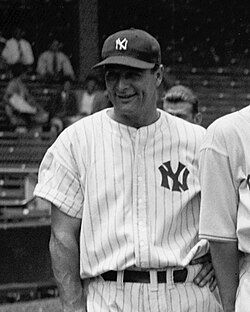
Lou Gehrig briefly held the single-season RBI record with his 175 in 1927 before Hack Wilson topped this total with 191 in 1930. In total Gehrig was responsible for three of the nine seasons in which a player hit 170 or more RBI.
In baseball, a run batted in (RBI) is awarded to a batter for each runner who scores as a result of the batter's action, including a hit, fielder's choice, sacrifice fly, bases loaded walk, or hit by pitch. A batter is also awarded an RBI for scoring himself upon hitting a home run. However, if a run scores because of an error that the defense commits on a batted ball, the batter does not (in most cases) receive an RBI; the exception is when the official scorer deems the run would've scored with or without an error, such as when an error occurs on a fielder's choice.
In Major League Baseball (MLB), a player in each league[L] wins the "RBI crown" or "RBI title" each season by hitting the most runs batted in that year. The first RBI champion in the National League (NL) was Deacon White; in the league's inaugural 1876 season, White hit 60 RBIs for the Chicago White Stockings. The American League (AL) was established in 1901, and Hall of Fame second baseman Nap Lajoie led that league with 125 RBIs for the Philadelphia Athletics. Over the course of his 27-season career, Cap Anson led the NL in RBI eight times. Babe Ruth and Honus Wagner have the second- and third-most RBI titles, respectively: Ruth with six, and Wagner with five. Several players are tied for the most consecutive seasons led with three: Anson (twice), Ty Cobb, Rogers Hornsby, Ruth, Joe Medwick, George Foster, and Cecil Fielder. Notably, Matt Holliday won the NL title in 2007 by one RBI over Ryan Howard, only overtaking Howard due to his performance in the 2007 National League Wild Card tie-breaker game. Had Howard won the 2007 title, he would have led the NL in a record four consecutive seasons from 2006 to 2009. The most recent champions are Kyle Tucker in the American League, and Matt Olson in the National League. (Full article...) -
Image 6
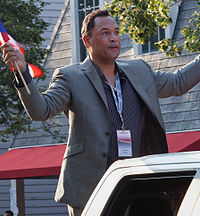
Roberto Alomar leads all second basemen with 10 Gold Glove Award wins.
The Gold Glove Award is the award given annually to the Major League Baseball players judged to have exhibited superior individual fielding performances at each fielding position in both the National League (NL) and the American League (AL), as voted by the managers and coaches in each league. Managers are not permitted to vote for their own players. Eighteen Gold Gloves are awarded each year (with the exception of 1957, 1985, 2007 and 2018), one at each of the nine positions in each league. In 1957, the baseball glove manufacturer Rawlings created the Gold Glove Award to commemorate the best fielding performance at each position. The award was created from a glove made from gold lamé-tanned leather and affixed to a walnut base. Initially, only one Gold Glove per position was awarded to the top fielder at each position in the entire league; however, separate awards were given for the National and American Leagues beginning in 1958.
Roberto Alomar leads second basemen in wins; he won 10 Gold Gloves in 11 years with three different American League teams. Ryne Sandberg has the second-highest total overall; his nine awards, all won with the Chicago Cubs, are the most by a National League player. Bill Mazeroski and Frank White are tied for the third-highest total, with eight wins. Mazeroski's were won with the Pittsburgh Pirates, and White won his with the Kansas City Royals. Joe Morgan and Bobby Richardson each won five Gold Glove Awards, and four-time winners include Craig Biggio (who won after converting to second base from catcher), Bret Boone, Bobby Grich, Orlando Hudson, Dustin Pedroia, and Brandon Phillips. Hall of Famers who won Gold Gloves at second base include Alomar, Sandberg, Mazeroski, Morgan, Biggio and Nellie Fox. (Full article...) -
Image 7Roberto Alomar's 1994 Gold Glove Award
The Rawlings Gold Glove Award, usually referred to as simply the Gold Glove, is the award given annually to the Major League Baseball (MLB) players judged to have exhibited superior individual fielding performances at each fielding position in both the National League (NL) and the American League (AL). The Gold Glove is widely considered one of the most prestigious defensive awards in baseball.
Winners for position awards are determined from voting by the managers and coaches in each league, who are not permitted to vote for their own players. Additionally, a sabermetric component provided by the Society for American Baseball Research (SABR) accounts for about 25 percent of the vote. For the utility player awards, the sabermetric component and other defensive statistics are exclusively used to select the winners, without any voting by coaches. (Full article...) -
Image 8

Mike Hampton has won five Silver Slugger Awards, best among all pitchers.
The Silver Slugger Award is awarded annually to the best offensive player at each position in both the American League (AL) and the National League (NL), as determined by the coaches and managers of Major League Baseball (MLB). These voters consider several offensive categories in selecting the winners, including batting average, slugging percentage, and on-base percentage, in addition to "coaches' and managers' general impressions of a player's overall offensive value". Managers and coaches are not permitted to vote for players on their own team. The Silver Slugger was first awarded in 1980 and is given by Hillerich & Bradsby, the manufacturer of Louisville Slugger bats. The award is a bat-shaped trophy, 3 feet (91 cm) tall, engraved with the names of each of the winners from the league and plated with sterling silver.
Only National League pitchers ever received a Silver Slugger Award; from the Silver Slugger Award's inception until 2019, and in 2021, a designated hitter generally took the place of the pitcher in the batting order in the American League. A Silver Slugger Award for designated hitters was given only in the American League during that time. (Full article...) -
Image 9
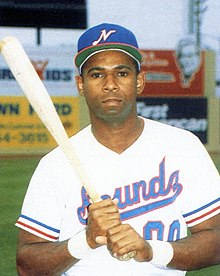
Skeeter Barnes played in 514 games for the Sounds, more than any other player in team history.
The Nashville Sounds Minor League Baseball team has played in Nashville, Tennessee, since its establishment in 1978. Through the completion of the 2023 season, 1,517 players have competed in at least one regular-season game for the Sounds. Of those, 1,095 have also played in at least one game for a Major League Baseball (MLB) team. Six additional players have appeared for the Sounds only in postseason games, one of whom has also played in the majors. Encompassing both regular and postseason play, 1,523 players have competed for Nashville; 1,096 of those have also played in Major League Baseball.
Created as an expansion team of the Double-A Southern League in 1978, the Sounds played in this league through 1984. At the Double-A classification, Nashville was affiliated with Major League Baseball's Cincinnati Reds (1978–1979) and New York Yankees (1980–1984). The Sounds moved up to Triple-A in 1985 as members of the American Association before joining the Pacific Coast League in 1998. With the restructuring of the minor leagues in 2021, they were placed in the Triple-A East, which became the International League in 2022. At this level, they have been affiliates of the Detroit Tigers (1985–1986), Cincinnati Reds (1987–1992), Chicago White Sox (1993–1997), Pittsburgh Pirates (1998–2004), Milwaukee Brewers (2005–2014), Oakland Athletics (2015–2018), and Texas Rangers (2019–2020). The Sounds reaffiliated with the Milwaukee Brewers in 2021. (Full article...) -
Image 10
Liván Hernández, who has made a total of four Opening Day starts for the Expos/Nationals franchise.
The Washington Nationals are a Major League Baseball (MLB) franchise based in Washington, D.C. They play in the National League East division. The team was known as the Montreal Expos from 1969 to 2004. The first game of the new baseball season for a team is played on Opening Day, and being named the Opening Day starter is an honor, which is often given to the player who is expected to lead the pitching staff that season, though there are various strategic reasons why a team's best pitcher might not start on Opening Day. The Nationals have used six different Opening Day starting pitchers in their sixteen seasons. The six starters have a combined Opening Day record of 3 win, 9 losses and 4 no decisions. No decisions are awarded to the starting pitcher if the game is won or lost after the starting pitcher has left the game, or if the starting pitcher does not pitch at least five innings with the lead. The overall Opening Day record of the team is 7–9.
Max Scherzer holds the franchise record for most Opening Day starts with five. He is 1–3 on Opening Day, with one no decision. (Full article...) -
Image 11In its 108-year history, the Minnesota Twins baseball franchise of Major League Baseball's American League has employed 31 managers. The duties of the manager include team strategy and leadership on and off the field. Eight of these team managers have been "player-managers", all during the Washington Senators era; specifically, they managed the team while still playing for it.
The Minnesota franchise began its life as the Washington Senators in Washington, D. C., where they played from their inception in 1901 to 1960. In the early twentieth century, the Senators were managed consecutively by three future members of the National Baseball Hall of Fame, bookended by Bucky Harris, who managed the team from 1924 to 1928 and again from 1935 to 1942. Walter Johnson managed the team for four seasons from 1929 to 1932, and he was followed by Joe Cronin, who led for the next two seasons (1933–1934). In 1960, the American League awarded an expansion franchise to Minneapolis, Minnesota; however, owner Calvin Griffith moved his team to Minnesota, and Washington was awarded the expansion team instead. Thus, the Minnesota Twins began play at Metropolitan Stadium in Bloomington, Minnesota the following year, during the tenure of manager Cookie Lavagetto, and played at the Hubert H. Humphrey Metrodome in downtown Minneapolis from 1982 to 2009. Under manager Ron Gardenhire, the team moved to Target Field beginning in the 2010 season. (Full article...) -
Image 12

Bob Jamison, announcer from 1979 to 1990, won the Southern League Broadcaster of the Year Award in 1980 and 1982.
The Nashville Sounds Minor League Baseball team has played in Nashville, Tennessee, since being established in 1978 as an expansion team of the Double-A Southern League. They moved up to Triple-A in 1985 as members of the American Association before joining the Pacific Coast League in 1998. In 2021, they were placed in the Triple-A East, which became the International League in 2022. The team has employed seven play-by-play announcers who have provided running commentary for their games' radio broadcasts on fourteen radio stations throughout their history.
As of 2024, all Sounds home and road games are broadcast on WBUZ-HD3 94.9 FM (AM 830). Live audio broadcasts are also available online through the team's website and the MiLB First Pitch app. Games can be viewed through the MiLB.TV subscription feature of the official website of Minor League Baseball, with audio provided by a radio simulcast. (Full article...) -
Image 13

Robin Yount (1973) is one of two Brewers first-round picks to be inducted in the National Baseball Hall of Fame.
The Milwaukee Brewers are a Major League Baseball (MLB) franchise based in Milwaukee, Wisconsin. They play in the National League Central division. Established in Seattle, Washington, as the Seattle Pilots in 1969, the team became the Milwaukee Brewers after relocating to Milwaukee in 1970. The franchise played in the American League until 1998, when it moved to the National League in conjunction with a major league realignment. Since the institution of MLB's Rule 4 draft, the Brewers have selected 69 players in the first round. Officially known as the "First-Year Player Draft", the Rule 4 draft is MLB's primary mechanism for assigning players from high schools, colleges, and other amateur clubs to its franchises. The draft order is determined based on the previous season's standings, with the team possessing the worst record receiving the first pick. In addition, teams which lost free agents in the previous off-season may be awarded compensatory or supplementary picks.
Of the 71 players picked in the first round by Milwaukee, 28 have been pitchers, the most of any position; 18 of these were right-handed, while 10 were left-handed. Fifteen outfielders, 13 shortstops, 5 third basemen, 4 first basemen, 3 catchers, and 3 second basemen were also taken. Fifteen of the players came from high schools or universities in the state of California, and Florida follows with ten players. (Full article...) -
Image 14Major League Baseball presents a variety of annual awards and trophies to recognize both its teams and its players. Three team trophies are awarded annually: one each to the National League and American League champions, and one of the champion of the World Series. Additionally, various organizations—such as the Baseball Writers' Association of America (BBWAA) and the Office of the Commissioner of Baseball—present awards for such accomplishments as excellence in batting, pitching performance, fielding prowess, and community service.
The Most Valuable Player Award, commonly known as the "MVP", is the oldest individual award, given in its current format since 1931. MVP awards are also presented for performances in the Major League Baseball All-Star Game, the League Championship Series, and the World Series. Offensive awards include the Silver Slugger Award and the Hank Aaron Award, while the Cy Young Award and Major League Baseball Reliever of the Year Award recognize pitching; the Rawlings Gold Glove Award is given for fielding. The newest award is the All-MLB Team, introduced in 2019 to honor the best players at each position across all of MLB. Before that time, the most recently established awards were the Major League Baseball Reliever of the Year Award and Major League Baseball Comeback Player of the Year Award, both established in 2005. Additionally, the Commissioner, at his discretion, can present an Historic Achievement Award for any great contribution to the sport that he deems worthy. (Full article...) -
Image 15

Carlos Zambrano was the Cubs' Opening Day starting pitcher from 2005 to 2010.
The Chicago Cubs are a Major League Baseball franchise based in Chicago that plays in the National League Central division. In the history of the franchise, it has also played under the names Chicago White Stockings, Chicago Colts and Chicago Orphans. The first game of the new baseball season for a team is played on Opening Day, and being named the Opening Day starter is an honor, which is often given to the player who is expected to lead the pitching staff that season, though there are various strategic reasons why a team's best pitcher might not start on Opening Day. The Cubs have used 68 different starting pitchers on Opening Day since they first became a Major League team in 1876. The Cubs have a record of 74 wins, 60 losses and 2 ties in their Opening Day games.
The Cubs have played in seven different home ball parks. They have played at their current home, Wrigley Field, since 1916. They have a record of 22 wins, 21 losses and 1 tie in Opening Day games at Wrigley Field. They had an Opening Day record of six wins, one loss and one tie at their other home ball parks, for a total home record in Opening Day games of 28 wins, 22 losses and 2 ties. Their record in Opening Day away games is 46 wins and 38 losses. (Full article...)
More did you know
- ... that despite its author keeping detailed journals of his experiences, the baseball memoir Odd Man Out was criticized by many people named in the book as being factually inaccurate?
- ... that the longest extra inning game in professional baseball history was an International League game that lasted 33 innings?
- ... that two members of the $100,000 infield have been inducted into the Baseball Hall of Fame?
- ... that three of the four batters faced by Mike Palagyi in his one Major League game were later inducted into the Baseball Hall of Fame?
- ... that Boston Red Sox third baseman Will Middlebrooks is engaged to a former Dallas Cowboys cheerleader whom he has known since childhood?
Sports portals
Selected picture

| Credit: User:UserB |
The Norfolk Tides, a Farm team for the Baltimore Orioles, take on the Columbus Clippers at Harbor Park
Associated Wikimedia
The following Wikimedia Foundation sister projects provide more on this subject:
-
Commons
Free media repository -
Wikibooks
Free textbooks and manuals -
Wikidata
Free knowledge base -
Wikinews
Free-content news -
Wikiquote
Collection of quotations -
Wikisource
Free-content library -
Wikiversity
Free learning tools -
Wiktionary
Dictionary and thesaurus
More portals
- Portals with triaged subpages from June 2018
- All portals with triaged subpages
- Portals with no named maintainer
- Automated article-slideshow portals with 51–100 articles in article list
- Automated article-slideshow portals with 501–1000 articles in article list
- Random portal component with 41–50 available subpages
- Automated article-slideshow portals with 201–500 articles in article list
- Random portal component with 11–15 available subpages
- Random portal component with 21–25 available image subpages




